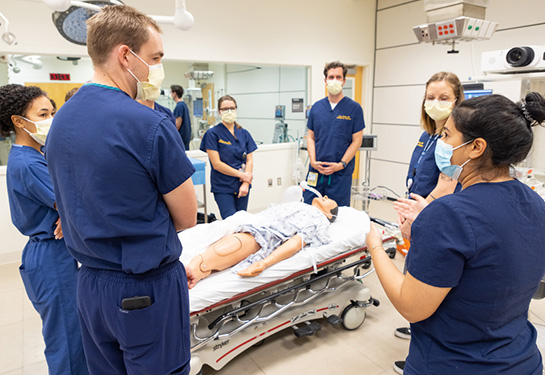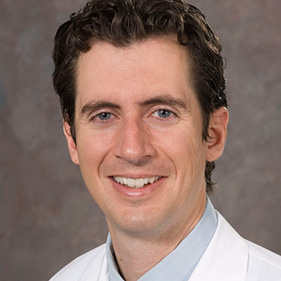New paper suggests health care simulation should train providers to think on their feet
Physicians regularly have to think on their feet when evaluating patients. That’s why Samuel Clarke of UC Davis Health and other leaders in academic medicine are proposing that the health education community re-design simulation-based teaching to emphasize this skill.
The authors make their case in a scholarly perspective published in the high-profile publication Academic Medicine. They argue that incorporating an approach grounded in what’s known as adaptive expertise might help learners better contend with the uncertainty and complexity clinicians face in patient care.
“The origins of health care simulation are rooted in helping clinicians perform their work safely,” said Clarke, associate professor of Emergency Medicine and co-director of simulation and medical education fellowship. “Historically, simulation educators have relied on performance-based models of teaching such as mastery learning.”
Mastery learning is designed to help hone skills with intention and repetition, while creating environments where teachers can measure and support a learner’s progress.
“These approaches have proven to be effective in helping clinicians learn to perform procedures safely and in helping teams to perform optimally in high stakes scenarios such as cardiac arrest resuscitation,” Clarke explained “However, they are less well-suited to situations in which the correct course of action is unknown, or a standard approach is unlikely to work.”
During a traditional simulation, trainees navigate a scripted scenario where there is typically a correct diagnosis at the end and an expected course of management. While this approach creates conditions that can be replicated and responses can be measured, it also tends to create highly curated experiences more like to puzzles than the complex problems encountered in clinical medicine.
“What I have really found is when residents do a lot of simulations, they're able to solve these puzzles quickly and act in a way that they probably wouldn't in real life,” Clarke said.
For example, learners might draw on extraneous clues (such as knowing that their instructor happens to be a toxicologist) that help prime them to approach the scenario in a particular way (e.g., being highly attuned to the possibility that a simulated patient is experiencing a drug overdose or has been poisoned).
Clarke went on to add, “In the emergency department, we are often faced with stark uncertainties about what is going on with a patient and we are having to entertain multiple possibilities simultaneously. Despite not always having a definitive diagnosis, we must act in a way that we feel certain is moving in the right direction.”
What is adaptive expertise?
Adaptive expertise is the ability to effectively apply knowledge to novel problems or atypical cases. It recognizes the importance of innovation and creativity in addition to expertise in the management of routine problems.
“Adaptive expertise is something that has been out there in medical education literature for a while,” said Clarke. “It's a balance between innovation and efficiency – when you're confronted with a problem for which there isn't a clearly right answer or procedure, you may need to come up with a bespoke solution.”
Adaptive expertise is something that has been out there in medical education literature for a while. It's a balance between innovation and efficiency – when you're confronted with a problem for which there isn't a clearly right answer or procedure, you may need to come up with a bespoke solution.” —Samuel Clarke
Clarke gives an example of a recent simulation he conducted with a group of emergency medicine residents that was intended to engage adaptive thinking. The patient presents to the emergency department via ambulance after falling down a flight of stairs. They also happen to be intoxicated and are in a cervical collar because the paramedics suspect they have fractured their neck.
Normally, for any trauma patient the first thing the emergency department team would do is try to get the patient to lay flat so they can perform a primary and secondary trauma survey. The patient would then be sent to the CT scanner to determine whether they do in fact have a broken neck. But what if that patient is so apprehensive about lying down that they refuse to leave a seated position?
“This is where adaptive expertise comes into play. Most of us would start with some pain medication to see whether we could get the patient to lay down, but what if that didn’t work?” Clarke asked. “You may have to try a different imaging modality, say, bring the x-ray machine to the bedside, some might try to sedate the patient, or might try to position them lying on their side rather than on their back. Often there are situations that do not fit with the way we normally do patient care and it's those sorts of problems where we must troubleshoot and might have to deviate from routine practice.”
Applying adaptive expertise to simulations
One of the ways Clarke and his team suggest teachers can help foster the development of adaptive expertise is by incorporating self-regulated learning (SRL) techniques to their simulations.
SRL is defined as self-generated thoughts, feeling and actions that are planned and cyclically adapted to the attainment of educational goals. It is characterized by three sequential phases: forethought (processes preceding action), performance (processes during action), and self-reflection (processes following action).
While traditional simulation relies on post-scenario debriefing to impart teaching points and clarify learners’ understanding, Clarke suggests using SRL to transform the debrief into a rolling dialogue between teacher and student.
“Using this technique would allow learners to articulate what they are experiencing during moments of uncertainty during a simulation and allow the facilitator to give them feedback about their strategic processes, regulatory processes, and motivational processes while they are performing a clinical task rather than only debriefing afterwards,” Clarke said. “This broadens the experience well beyond what we can achieve by having residents behave like actors in a play. By engaging their thought processes as they move forward through a simulation, we come closer to the interactions that might happen in the resus bay, the ICU or the OR, but with the advantage of being able to stop and start time at will, do things over or try things more than one way.”
Clinicians of all stripes must think on their feet all the time. It's something that we must learn, and unfortunately it isn’t just the natural byproduct of experience. It’s a skill that can be learned and we can use simulation to explicitly foster that type of growth.” —Samuel Clarke
Overall, the authors propose simulation practices shift from outcome-based orientations that emphasize “doing things right,” to a process-based orientation that emphasizes “doing the right things.”
“Clinicians of all stripes must think on their feet all the time. It's something that we must learn, and unfortunately it isn’t just the natural byproduct of experience,” explained Clarke. “It’s a skill that can be learned and we can use simulation to explicitly foster that type of growth.”
The coauthors on the paper are Jonathan S. Ilgen, professor of emergency medicine at the University of Washington Medical Center and Glenn Regehr, associate director of research at the Centre for Health Education Scholarship at the University of British Columbia.





